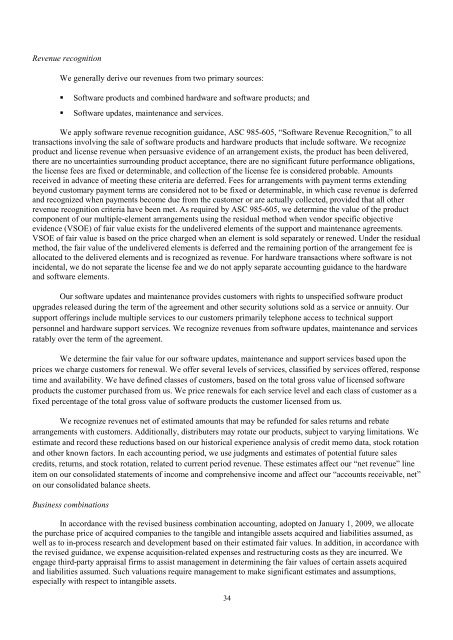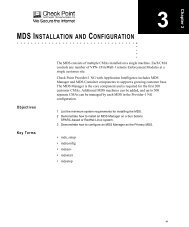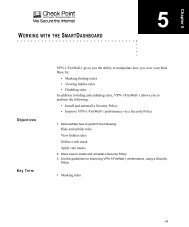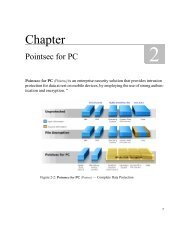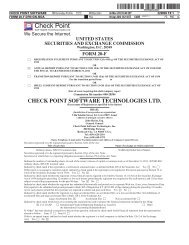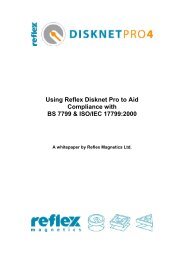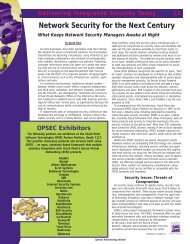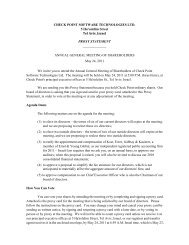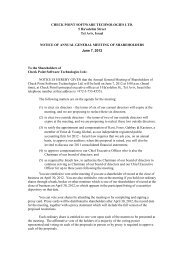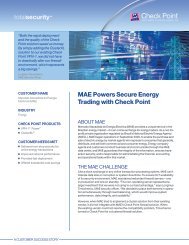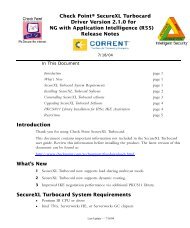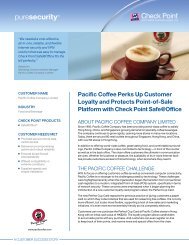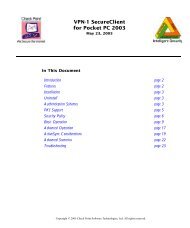FORM 20-F - Check Point
FORM 20-F - Check Point
FORM 20-F - Check Point
You also want an ePaper? Increase the reach of your titles
YUMPU automatically turns print PDFs into web optimized ePapers that Google loves.
Revenue recognition<br />
We generally derive our revenues from two primary sources:<br />
� Software products and combined hardware and software products; and<br />
� Software updates, maintenance and services.<br />
We apply software revenue recognition guidance, ASC 985-605, “Software Revenue Recognition,” to all<br />
transactions involving the sale of software products and hardware products that include software. We recognize<br />
product and license revenue when persuasive evidence of an arrangement exists, the product has been delivered,<br />
there are no uncertainties surrounding product acceptance, there are no significant future performance obligations,<br />
the license fees are fixed or determinable, and collection of the license fee is considered probable. Amounts<br />
received in advance of meeting these criteria are deferred. Fees for arrangements with payment terms extending<br />
beyond customary payment terms are considered not to be fixed or determinable, in which case revenue is deferred<br />
and recognized when payments become due from the customer or are actually collected, provided that all other<br />
revenue recognition criteria have been met. As required by ASC 985-605, we determine the value of the product<br />
component of our multiple-element arrangements using the residual method when vendor specific objective<br />
evidence (VSOE) of fair value exists for the undelivered elements of the support and maintenance agreements.<br />
VSOE of fair value is based on the price charged when an element is sold separately or renewed. Under the residual<br />
method, the fair value of the undelivered elements is deferred and the remaining portion of the arrangement fee is<br />
allocated to the delivered elements and is recognized as revenue. For hardware transactions where software is not<br />
incidental, we do not separate the license fee and we do not apply separate accounting guidance to the hardware<br />
and software elements.<br />
Our software updates and maintenance provides customers with rights to unspecified software product<br />
upgrades released during the term of the agreement and other security solutions sold as a service or annuity. Our<br />
support offerings include multiple services to our customers primarily telephone access to technical support<br />
personnel and hardware support services. We recognize revenues from software updates, maintenance and services<br />
ratably over the term of the agreement.<br />
We determine the fair value for our software updates, maintenance and support services based upon the<br />
prices we charge customers for renewal. We offer several levels of services, classified by services offered, response<br />
time and availability. We have defined classes of customers, based on the total gross value of licensed software<br />
products the customer purchased from us. We price renewals for each service level and each class of customer as a<br />
fixed percentage of the total gross value of software products the customer licensed from us.<br />
We recognize revenues net of estimated amounts that may be refunded for sales returns and rebate<br />
arrangements with customers. Additionally, distributers may rotate our products, subject to varying limitations. We<br />
estimate and record these reductions based on our historical experience analysis of credit memo data, stock rotation<br />
and other known factors. In each accounting period, we use judgments and estimates of potential future sales<br />
credits, returns, and stock rotation, related to current period revenue. These estimates affect our “net revenue” line<br />
item on our consolidated statements of income and comprehensive income and affect our “accounts receivable, net”<br />
on our consolidated balance sheets.<br />
Business combinations<br />
In accordance with the revised business combination accounting, adopted on January 1, <strong>20</strong>09, we allocate<br />
the purchase price of acquired companies to the tangible and intangible assets acquired and liabilities assumed, as<br />
well as to in-process research and development based on their estimated fair values. In addition, in accordance with<br />
the revised guidance, we expense acquisition-related expenses and restructuring costs as they are incurred. We<br />
engage third-party appraisal firms to assist management in determining the fair values of certain assets acquired<br />
and liabilities assumed. Such valuations require management to make significant estimates and assumptions,<br />
especially with respect to intangible assets.<br />
34


